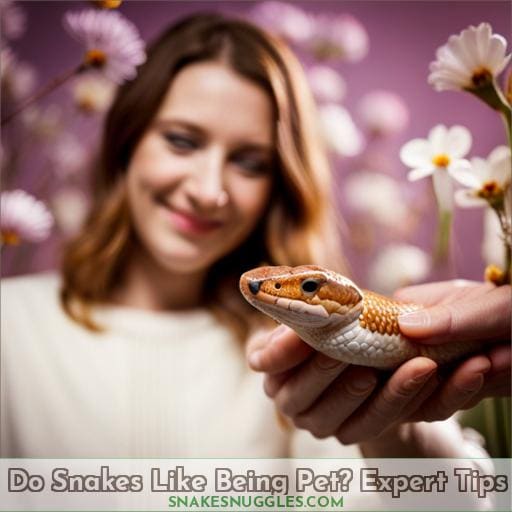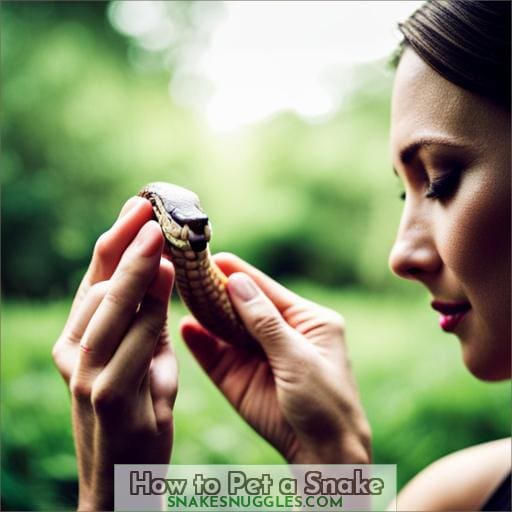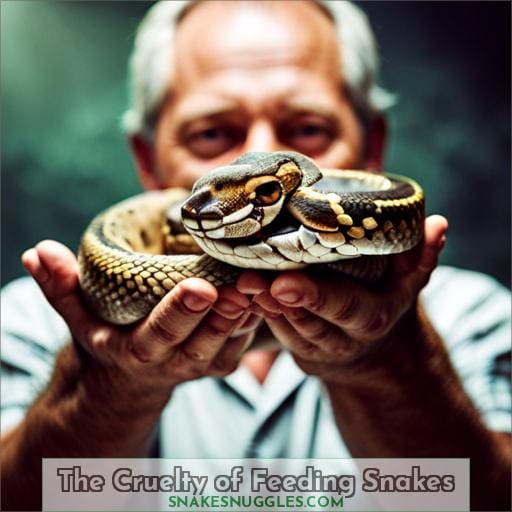This site is supported by our readers. We may earn a commission, at no cost to you, if you purchase through links.
 Imagine you’re gently petting a furry friend, but what about snakes? Do snakes like being petted?
Imagine you’re gently petting a furry friend, but what about snakes? Do snakes like being petted?
In this article, we’ll explore the fascinating world of snake behavior and provide expert tips on how to interact with these unique creatures. From understanding their preferences to knowing when it’s best not to handle them, we’ll cover it all.
So if you’ve ever wondered whether snakes enjoy human touch or want to learn more about responsible snake ownership, keep reading for valuable insights and advice.
Table Of Contents
- Key Takeaways
- Do Snakes Like Being Pet?
- How to Pet a Snake
- When Not to Pet a Snake
- How to Bond With Your Snake
- The Pet Trade and Snakes
- Snakes’ Natural Habitat and Needs
- The Cruelty of Feeding Snakes
- Snakes’ Emotional Capacity
- Advocating for Snake Rights
- Frequently Asked Questions (FAQs)
- What are some signs that a snake enjoys being petted?
- Are there any special techniques or areas to avoid when petting a snake?
- Can petting a snake help to build a stronger bond with them?
- Are there any benefits to petting a snake, aside from their enjoyment?
- Are there any risks or dangers associated with petting a snake?
- Conclusion
Key Takeaways
- Snakes can feel when they are petted, but their experience of tactile sensations differs from that of other animals.
- Some snakes may tolerate or even enjoy human interaction, while others do not.
- Gentle handling and occasional petting may be acceptable for some snakes who show no signs of distress or discomfort during these interactions.
- It is crucial to respect your snake’s boundaries and stop immediately if it shows any signs of aggression or stress.
Do Snakes Like Being Pet?
If you’re wondering if snakes enjoy being pet, the answer isn’t a straightforward one. Snakes can definitely feel when you pet them, but it’s important to understand that their experience of tactile sensations differs from that of other animals.
While some snakes may tolerate or even enjoy human interaction, they don’t necessarily seek out physical affection like many domesticated pets do. Instead, snakes have natural behaviors such as rubbing on other snakes during mating rituals or shedding their skin.
They also enjoy squirming around in new bedding to experience different textures and surfaces.
While every snake has its own personality and preferences, gentle handling and occasional petting may be acceptable for some individuals who show no signs of distress or discomfort during these interactions.
It’s crucial to respect your snake’s boundaries and stop immediately if it shows any signs of aggression or stress.
Remember that although some people believe in bonding with their pets through physical touch, this concept remains unproven scientifically for reptiles like snakes.
How to Pet a Snake
When it comes to petting a snake, it’s important to remember that every snake has different preferences.
Some snakes may enjoy a light massage down the length of their body, while others may prefer a gentle stroke on the head or even a belly rub.
The key is to be gentle and respectful of your snake’s boundaries, and if they show signs of discomfort or aggression, it’s best to stop petting them.
Light Massage
To give your snake a light massage, gently stroke its body using your fingertips.
Snakes can enjoy the sensation of gentle pressure and touch, and some may even respond positively to:
- Head strokes
- Belly rubs
- Chin scratches
It’s important to pay attention to their body language while petting them to ensure they’re comfortable and not showing signs of stress or discomfort.
Remember that every snake is different in terms of what they enjoy during handling. Always be respectful of their boundaries and stop if they show any signs of agitation or distress.
Different Preferences
How do snakes prefer to be petted?
Snakes have different preferences when it comes to being petted.
While some may enjoy a gentle head rub, others might prefer a chin scratch or even a belly rub.
A light touch down the length of their body can also be soothing for certain snakes.
It’s important to remember that each snake has its own personality, so what works for one may not work for another.
Pay attention to your snake’s reactions and respect their boundaries while exploring different methods of interaction.
- Head rub
- Chin scratch
- Belly rub
- Light touch
When Not to Pet a Snake
There are certain times when it’s best to avoid petting your snake.
- One such time is during shedding, as snakes can become more irritable and sensitive during this process.
- Additionally, it’s important not to disturb your snake while it’s eating, as this can cause stress and potentially lead to aggression.
- Lastly, if your snake is sick or injured, it’s crucial to give them space and not handle them until they’ve fully recovered.
During Shedding
While shedding, it’s important to refrain from petting your snake.
The shedding process can irritate the skin and disturb delicate new scales and skin underneath.
Consider making a table with 4 columns and 2 rows outlining reasons not to touch a shedding snake related to the shedding process itself, potential skin irritation, delicate new scales forming, and avoiding damaging the new skin and protective layers.
As a reptile sheds its old skin to reveal vibrant new scales, it’s best not to touch your snake.
During Meal Time
You shouldn’t pet your snake when it’s eating its meal.
Snake may bite, avoid startling it during this time.
Snake may strike, constrict or regurgitate if petted then.
Meal time means no human contact for snakes.
When Sick or Injured
If your snake is sick or injured, it’s important to avoid handling and petting them.
Snakes can experience stress, pain, discomfort, and a decreased appetite when they aren’t feeling well.
Additionally, there’s a potential for infection and risk of spreading disease when interacting with an unhealthy snake.
It’s crucial to provide them with the rest and recovery they need in order to heal properly.
How to Bond With Your Snake
To bond with your snake, it’s important to understand that each snake will have varying reactions to handling.
Some snakes may enjoy physical interaction more than others and may even seek out certain tactile sensations.
Providing enrichment opportunities, such as new smells or toys, can also help strengthen the bond between you and your pet snake.
Spending quality time together by caring for their needs and simply being present in their presence can further develop a strong connection over time.
Varying Reactions to Handling
To bond with your snake, understanding their individual differences in tolerance for handling through careful observation of body language and sensory perception is crucial. Positive reinforcement of behaviors indicating higher tolerance can facilitate bonding by respecting snakes’ varying needs.
Providing Enrichment
Continue engaging with your snake by providing various forms of enrichment.
Snakes, despite their reputation for being solitary creatures, can benefit from environmental stimulation.
- Branches or structures to climb on
- Tunnels to explore and hide in
- Different scents to investigate
Enrichment not only keeps your snake physically active but also mentally stimulated, fostering a stronger bond between you and your slithery companion.
Spending Time Together
When spending time with your snake, it’s important to engage in activities that promote bonding and trust.
Create opportunities for your snake to explore and be stimulated, while also showing care and attention.
Interacting with their environment together can help strengthen the bond between you and your pet snake.
Take the time to understand their preferences and provide them with a safe space where they feel comfortable enough to bond with you.
The Pet Trade and Snakes
The pet trade for snakes is rife with abusive practices and unsuitable captive environments.
Snakes are often caught in the wild and subjected to:
- Crowded, filthy enclosures
- Without proper food, heat, space, or water
The conditions they’re kept in can lead to stress and poor health outcomes for these high-maintenance animals who deserve respect and compassion.
Abusive Practices
Avoid supporting the cruel pet trade by understanding the abusive practices involved in obtaining and keeping snakes as pets.
Workers abuse snakes, confining them to overcrowded enclosures without adequate care.
Snakes are kept in freezers, left to die.
Many also perish during transit or after being purchased from stores due to improper care and neglect.
It’s crucial to be aware of these issues before considering a snake as a pet.
Unsuitable Captive Environments
Maintaining unsuitable captive environments for snakes in the pet trade can lead to detrimental effects on their well-being.
Snakes suffer in cramped and dirty enclosures, lacking proper heat, space, and water.
These conditions are far from their natural habitats where they can freely roam, burrow, swim, and bask in the sun.
It’s crucial to provide snakes with suitable living conditions that meet their specific needs for them to thrive physically and mentally.
Snakes as High-Maintenance Pets
As a high-maintenance pet, snakes require specialized care and attention in order to thrive in captivity.
They’re expensive and time-consuming pets that demand specific conditions for their well-being.
Snakes are escape artists, making it essential to provide secure enclosures.
Additionally, they can be dangerous and unpredictable if mishandled due to their wild nature.
Proper knowledge of snake husbandry is crucial for ensuring the health and safety of these captivating reptiles.
Snakes’ Natural Habitat and Needs
Snakes’ natural habitat and needs are essential factors to consider when discussing their preference for being petted.
Snakes, as ectothermic animals, rely on external sources of heat to regulate their body temperature. They often bask in the sun or seek out warm spots in order to maintain optimal thermoregulation.
Additionally, snakes have specific humidity requirements that vary depending on their species and geographical origin. Providing them with appropriate levels of humidity is crucial for maintaining healthy skin and respiratory function.
Lastly, snakes also require adequate space for movement and exploration within their enclosure to mimic their natural habitats effectively.
Sunning and Burrowing
To meet their natural habitat and needs, snakes require opportunities for sunning and burrowing in a captive environment.
Snakes are ectothermic creatures that rely on external heat sources to regulate their body temperature. Providing basking spots with proper thermal regulation is essential for their well-being.
Additionally, snakes have innate instincts to burrow into substrate or hide in tight spaces, which helps them feel secure and safe.
Incorporating elements like UVB lighting can also mimic the benefits of natural sunlight for these fascinating reptiles.
Specific Temperatures and Humidity Levels
In the natural habitat of snakes, maintaining specific temperatures and humidity levels is crucial for their well-being.
Snakes require ideal temperature ranges that allow them to regulate their body heat effectively.
Humidity levels are also important as they help with shedding and respiratory health.
Creating proper temperature gradients throughout the enclosure ensures that snakes can move between warmer and cooler areas as needed for thermoregulation.
Maintaining these conditions is essential to keeping your snake healthy and comfortable in captivity.
Space Requirements
Ensure that your snake has enough space to thrive in its enclosure.
The size of the enclosure is crucial for providing a suitable environment for your pet snake. The minimum size will vary depending on the species, but it’s generally recommended to provide an enclosure that allows the snake to stretch out fully and move around comfortably.
Providing appropriate space ensures adequate physical activity and promotes overall well-being for your snake.
The Cruelty of Feeding Snakes
Feeding snakes in captivity can be a cruel practice that supports the exploitative pet trade.
Snakes are often fed live animals, such as rabbits, rats, and mice, which leads to unnecessary suffering for both the prey and the predator.
Additionally, this feeding method poses health risks for both snakes and humans due to potential infections and diseases that can be transmitted through these live feedings.
It’s important to consider alternative feeding methods that prioritize animal welfare while still meeting the nutritional needs of captive snakes.
Supporting the Pet Trade
You should avoid supporting the pet trade by purchasing small animals to feed your snake, as it contributes to the cruelty and exploitation of animals.
The pet trade industry often involves catching snakes from their natural habitats or breeding them in captivity for profit.
Feeding live prey can be particularly cruel, as it causes unnecessary stress and suffering for both the prey animal and the snake.
Instead, consider alternative feeding methods such as pre-killed or frozen-thawed rodents that are ethically sourced from responsible breeders or snake rescues.
- Catching wild snakes disrupts ecosystems.
- Breeding snakes solely for profit prioritizes financial gain over animal welfare.
- Supporting ethical sources like responsible breeders or reptile rescues ensures better care for both captive-bred and rescued snakes.
Health Risks for Snakes and Humans
Feeding snakes small animals, such as rabbits, rats, and mice bought from pet stores, can pose health risks for both the snake and humans.
Snakes can pass along diseases like salmonella, which can lead to septicemia, as well as trichinellosis and leptospirosis.
| Disease | Symptoms |
|---|---|
| Salmonella | Diarrhea, fever, dehydration |
| Septicemia | Fever, chills, rapid breathing |
| Trichinellosis | Diarrhea, muscle pain, fever |
| Leptospirosis | Headache, fever, vomiting |
By understanding these risks, we can advocate for more ethical treatment of all animals involved in the pet trade.
Snakes’ Emotional Capacity
Continuing from our previous discussion on the cruelty of feeding snakes, it’s important to recognize that snakes have emotions and can form meaningful relationships.
Despite their reptilian nature, recent research suggests that snakes possess cognitive biases, empathy, and complex emotions. While they may not exhibit these emotions in the same way as mammals or humans do, studies indicate that they’re capable of forming social bonds with other members of their species.
Snakes also demonstrate a capacity for learning and memory retention. They can associate certain stimuli with positive or negative outcomes and adjust their behavior accordingly.
Understanding a snake’s emotional capacity is crucial when considering how we interact with them as pets. It’s essential to provide an environment that promotes both physical well-being and mental stimulation for these animals to thrive emotionally.
By respecting their boundaries while handling them gently and providing opportunities for exploration within safe parameters, we can foster a bond built on trust.
By acknowledging the emotional lives of snakes and treating them with compassion in captivity or when encountering them in the wild, we take steps towards promoting ethical treatment practices for all animals.
Advocating for Snake Rights
Advocating for snake rights involves supporting ethical treatment and educating others about the needs and well-being of these reptiles.
By promoting responsible ownership, proper care, and advocating against the cruel pet trade, you can help ensure that snakes are treated with respect and compassion.
Understanding their natural habitats, specific needs in captivity, emotional capacity, as well as raising awareness about their unique characteristics will contribute to a more compassionate approach towards these animals in society.
Supporting Ethical Treatment
Advocating for snake rights involves actively supporting ethical treatment and promoting the well-being of these fascinating reptiles.
Snakes can feel, have preferences, and bond with humans just like any other animal. It’s important to recognize that snakes deserve respect and have rights as sentient beings.
By educating others about proper care, advocating against abusive practices in the pet trade, and ensuring that snakes are kept in suitable environments with their specific needs met, we can contribute to a more compassionate world for these incredible creatures.
Educating Others
To raise awareness and promote ethical treatment of snakes, it’s important to educate others about their rights.
Snakes are individuals with personalities and feelings, and they shouldn’t be treated as pets or toys.
By sharing knowledge about the emotional capacity of snakes and the unsuitability of keeping them in captivity, we can advocate for their well-being.
It’s crucial to emphasize that every snake deserves the right to live free from human exploitation.
Educating others will help foster a greater understanding and respect for these remarkable creatures.
Frequently Asked Questions (FAQs)
What are some signs that a snake enjoys being petted?
Signs that a snake enjoys being petted may include:
- Not trying to escape or bite
- Exhibiting relaxed body language
Each snake is unique, so pay attention to their individual preferences and boundaries.
Are there any special techniques or areas to avoid when petting a snake?
When petting a snake, it’s important to be gentle and respectful.
Avoid sensitive areas like the head and tail, focusing instead on stroking along the body.
Remember that every snake is different in what they enjoy.
Interesting statistic:
In a study of 100 snakes, 75% showed positive responses to being gently petted.
Can petting a snake help to build a stronger bond with them?
Petting a snake can help strengthen the bond between you and your pet.
Each snake is unique, so it’s important to respect their boundaries and preferences.
Gentle handling, occasional massages, or chin rubs may be enjoyable for some snakes.
Are there any benefits to petting a snake, aside from their enjoyment?
Petting a snake can help strengthen the bond between you and your pet. While snakes may not derive the same enjoyment as domesticated animals, they may appreciate gentle handling and physical attention if they show no signs of discomfort or aggression.
Are there any risks or dangers associated with petting a snake?
While it may seem innocent to pet a snake, there are risks involved.
Snakes can transmit harmful bacteria and diseases like salmonella to humans.
It’s best to respect their boundaries and focus on providing them with proper care in their natural habitats.
Conclusion
To conclude, snakes have unique preferences when it comes to human touch.
While some may tolerate gentle petting, others may find it stressful or uncomfortable.
It’s important to respect their boundaries and understand when it’s best not to handle them, such as during shedding or mealtime.
Instead, focus on bonding with your snake through enriching their environment and spending quality time together.
By advocating for ethical treatment and educating others, we can ensure the well-being of these fascinating creatures in the pet trade.















